the place where Paleontology and Paleoanthropology meets Philately
Moldova
Prehistoric animals, Charles Darwin, Natural History Museums on stamps, postmarks and postal stationeries of Moldova
| << previous country | back to index | next country >> |
Contents:
- Country overview
- Philately of Moldova
- Official stamps of Moldova related to Paleontology
- Other stamps of Moldova to consider
- Some commemorative postmarks of Moldova to consider
- Some postal stationeries of Moldova to consider
- References
- Acknowledgements
Moldova, officially the Republic of Moldova, is a landlocked country in Eastern Europe, bordered by Romania to the west and Ukraine to the north, east, and south. The capital city is Chișinău.
Moldova declared independence on 27 August 1991, as part of the dissolution of the Soviet Union. The current Constitution of Moldova was adopted in 1994.
A strip of Moldovan territory on the east bank of the river Dniester has been under the de facto control of the breakaway government of Transnistria since 1990.
Moldova is the poorest country in Europe.
Moldova is a parliamentary republic with a president as head of state and a prime minister as head of government. [R1]
Moldova’s geologic record extends from Archean rocks (the early Precambrian – at least 2.5 billion years ago) to the Miocene and Pliocene (23 to 5 million years ago) – unfortunately most of this rock record is covered up by younger Quaternary deposits from the last ice age to the present. Some Miocene and Pliocene rocks outcrop at the surface and have been studied extensively by Moldovan and Romanian paleontologists (and in the past, Soviet paleontologists). Much of the older rock record is only known from drilling wells and examining the rock materials intercepted during drilling. During the Miocene, southern and central Moldova were under water – flooded by a sea that filled in the foreland basin adjacent to the growing Carpathian Mountains. Northern Moldova was characterized by coastal environments (beaches) and a mix of riparian forests, swamps, and open grasslands with a diverse fauna of mammals. By the Pliocene, the foreland basin had filled in with sediment as part of the evolution of the modern Danube river system. During the lower Pliocene, Moldova was characterized by a mixed forest-steppe landscape. Roughly at the mid-point of the Pliocene, broad-leaved forests dominated the landscape. But with the cooling of the Earth into the Plio-Pleistocene glaciations, the forests retreated and were replaced by the modern steppe landscape (Matoshko et al. (2019) provide a very nice overview of this landscape evolution). [R4]
The first stamps of independent Moldova were designed by Grigoriy Bronza and issued in 1991. [R2]
Official stamps of Moldova related to Paleontology: prehistoric animals and their fossils, Charles Darwin
| 06.04.1995 "Exhibits from the National Ethnographic Museum" [1] | 24.11.2009 "Famous persons" [2] | 30.11.2010 "Prehistoric animals" |
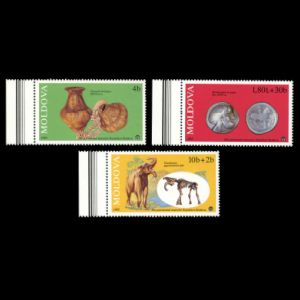 |
 |

|
| 29.10.2016 "Extinct animals" | 18.05.2024 "National Museum of Ethnography and Natural History" | |
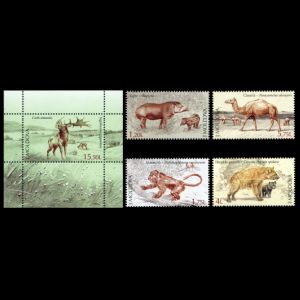 |
 |
|
Notes:
[1] Stamp with a value of "10b+2b" depicts Dinotherium (Deinotherium) gigantissimum. The skeleton was found in 1966 near the village of Pripiceni, Moldova. The first description of this animal was made by the scientist Grigoriu Stefanescu (1836-1911), Romanian paleontologist.
[2] Charles Darwin is shown on the stamp with face value of 7L.
Charles Darwin (1809 -1882)
was an English naturalist, geologist and biologist, best known for his contributions to the theory of evolution.
His proposition that all species of life have descended from common ancestors,
published in his most famous book "On the Origin of Species" in 1859.
This theory is now widely accepted and considered a fundamental concept in all biological science, including paleontology.
Other stamps of Moldova to consider: Natural History Museum
| 03.05.2014 "National Museums of the Republic of Moldova" [A1] | 15.11.2017 "Personalities" [A1] | |
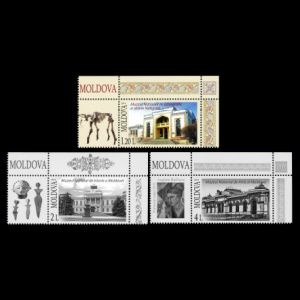 |
 |
Notes:

|
| Dinotherium (Deinotherium) gigantissimum on National Museums of the Republic of Moldova stamp 2014, MiNr.: 866, Scott: 821 |
Every stamp issued in mini sheets of 10 stamps: 5 rows of 2 stamps with various images on labels in between.
One of the labels of a mini-sheet of The National Museum of Ethnography and Natural History stamps sheet shows fossilized skeleton of Deinotherium giganteum from the Museum's collection.
(Deinotherium had already appeared on a stamp produced by Moldova in 1995).

|
The stamp with the face value of 5.20 Lei of "Personalities" stamps set from 2017, shows National Museum of Ethnography and Natural History and its first director Mr. A. Stuart (1842-1917) MiNr.: 1025, Scott: 963, see on the right.
The similar design was used on the cachet and the imprinted stamp of a postal stationery of Moldova 2005.
For more details about the Museum and its paleontological collection, please click here.
Some commemorative postmarks of Moldova to consider: Natural History Museum
| 06.04.1995 "Exhibits from the National Ethnographic Museum" [A1] [FDC] | 24.10.2014 "125th anniversary of National Museum of Ethnography and Natural History" [Sp] | 24.10.2019 "130th anniversary of National Museum of Ethnography and Natural History" [Sp] |
 |
 |
 |
Some postal stationeries of Moldova to consider: Natural History Museums, contributor to Paleontology science
| 2005 "National Museum of Ethnography and Natural History and its first director Mr. A. Stuart (1842-1917)" [A1] | 2014 "120th anniversary of National Museum of Ethnography and Natural History" [A1] | 24.10.2014 "125th anniversary of National Museum of Ethnography and Natural History" [A1] |
 |
 |
 |
| 14.03.2016 "140th anniversary of Lev Semyonovich Berg" [PS1] | 24.10.2019 "130th anniversary of National Museum of Ethnography and Natural History [A1] | |
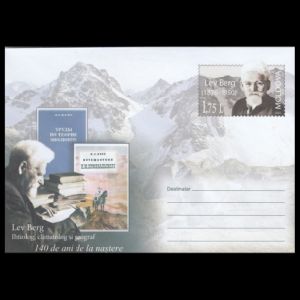 |
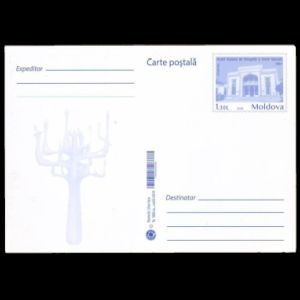 |
|
Notes:
[PS1] Lev Semyonovich Berg (March 14, 1876, Bender – December 24, 1950) was a leading Soviet geographer, biologist and ichthyologist who served as President of the Soviet Geographical Society between 1940 and 1950.
He also developed his own evolutionary theory (Nomogenesis) as opposed to the theories of Darwin and Lamarck.
Studied both modern and prehistoric fishes, one of his most famous publication is "Classification of fishes, both recent and fossil" published in 1940, Between 1934-1950 - Director of the Laboratory of fossil fish of the Zoological Institute of the USSR in Leningrad. [R3]
- [R1] Moldova: Wikipedia, WikiTravel FlagCounter
- [R2] Postal History and Philately of Moldova:
Wikipedia,
Links to official website of the Post Authority, stamp catalog and a list of new stamps of Moldova are here - [R3] Lev Semyonovich Berg: Wikipedia,
- [R4] Moldova’s geologic record: "Prehistoric Life on Moldovan Stamps", by Dr. Peter Voice.
Acknowledgements:
Many thanks to
- Dr. Peter Voice from Department of Geological and Environmental Sciences, Western Michigan University, for reviewing the draft page and his valuable comments.
- Mr. Alexander Pedchenko from Russia, for his help in finding some missing philatelic stuff of Moldova.
| << previous country | back to index | next country >> |